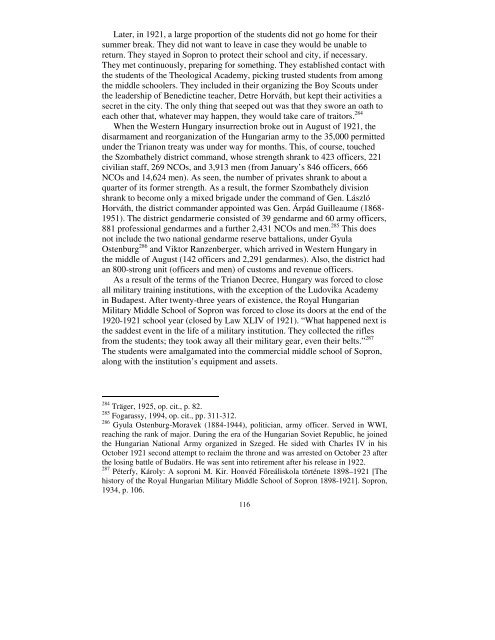The Fate of Western Hungary 1918-1921 - Corvinus Library ...
The Fate of Western Hungary 1918-1921 - Corvinus Library ...
The Fate of Western Hungary 1918-1921 - Corvinus Library ...
You also want an ePaper? Increase the reach of your titles
YUMPU automatically turns print PDFs into web optimized ePapers that Google loves.
Later, in <strong>1921</strong>, a large proportion <strong>of</strong> the students did not go home for their<br />
summer break. <strong>The</strong>y did not want to leave in case they would be unable to<br />
return. <strong>The</strong>y stayed in Sopron to protect their school and city, if necessary.<br />
<strong>The</strong>y met continuously, preparing for something. <strong>The</strong>y established contact with<br />
the students <strong>of</strong> the <strong>The</strong>ological Academy, picking trusted students from among<br />
the middle schoolers. <strong>The</strong>y included in their organizing the Boy Scouts under<br />
the leadership <strong>of</strong> Benedictine teacher, Detre Horváth, but kept their activities a<br />
secret in the city. <strong>The</strong> only thing that seeped out was that they swore an oath to<br />
each other that, whatever may happen, they would take care <strong>of</strong> traitors. 284<br />
When the <strong>Western</strong> <strong>Hungary</strong> insurrection broke out in August <strong>of</strong> <strong>1921</strong>, the<br />
disarmament and reorganization <strong>of</strong> the Hungarian army to the 35,000 permitted<br />
under the Trianon treaty was under way for months. This, <strong>of</strong> course, touched<br />
the Szombathely district command, whose strength shrank to 423 <strong>of</strong>ficers, 221<br />
civilian staff, 269 NCOs, and 3,913 men (from January’s 846 <strong>of</strong>ficers, 666<br />
NCOs and 14,624 men). As seen, the number <strong>of</strong> privates shrank to about a<br />
quarter <strong>of</strong> its former strength. As a result, the former Szombathely division<br />
shrank to become only a mixed brigade under the command <strong>of</strong> Gen. László<br />
Horváth, the district commander appointed was Gen. Árpád Guilleaume (1868-<br />
1951). <strong>The</strong> district gendarmerie consisted <strong>of</strong> 39 gendarme and 60 army <strong>of</strong>ficers,<br />
881 pr<strong>of</strong>essional gendarmes and a further 2,431 NCOs and men. 285 This does<br />
not include the two national gendarme reserve battalions, under Gyula<br />
Ostenburg 286 and Viktor Ranzenberger, which arrived in <strong>Western</strong> <strong>Hungary</strong> in<br />
the middle <strong>of</strong> August (142 <strong>of</strong>ficers and 2,291 gendarmes). Also, the district had<br />
an 800-strong unit (<strong>of</strong>ficers and men) <strong>of</strong> customs and revenue <strong>of</strong>ficers.<br />
As a result <strong>of</strong> the terms <strong>of</strong> the Trianon Decree, <strong>Hungary</strong> was forced to close<br />
all military training institutions, with the exception <strong>of</strong> the Ludovika Academy<br />
in Budapest. After twenty-three years <strong>of</strong> existence, the Royal Hungarian<br />
Military Middle School <strong>of</strong> Sopron was forced to close its doors at the end <strong>of</strong> the<br />
1920-<strong>1921</strong> school year (closed by Law XLIV <strong>of</strong> <strong>1921</strong>). “What happened next is<br />
the saddest event in the life <strong>of</strong> a military institution. <strong>The</strong>y collected the rifles<br />
from the students; they took away all their military gear, even their belts.” 287<br />
<strong>The</strong> students were amalgamated into the commercial middle school <strong>of</strong> Sopron,<br />
along with the institution’s equipment and assets.<br />
284 Träger, 1925, op. cit., p. 82.<br />
285 Fogarassy, 1994, op. cit., pp. 311-312.<br />
286 Gyula Ostenburg-Moravek (1884-1944), politician, army <strong>of</strong>ficer. Served in WWI,<br />
reaching the rank <strong>of</strong> major. During the era <strong>of</strong> the Hungarian Soviet Republic, he joined<br />
the Hungarian National Army organized in Szeged. He sided with Charles IV in his<br />
October <strong>1921</strong> second attempt to reclaim the throne and was arrested on October 23 after<br />
the losing battle <strong>of</strong> Budaörs. He was sent into retirement after his release in 1922.<br />
287 Péterfy, Károly: A soproni M. Kir. Honvéd Főreáliskola története 1898–<strong>1921</strong> [<strong>The</strong><br />
history <strong>of</strong> the Royal Hungarian Military Middle School <strong>of</strong> Sopron 1898-<strong>1921</strong>]. Sopron,<br />
1934, p. 106.<br />
116
















